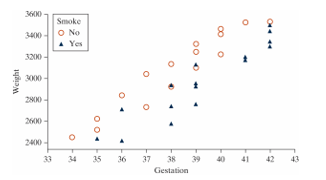Multiple Choice
Babies born with low birth weights (less than 2500 grams) are at an increased risk for many infant diseases. Researchers in North Carolina collected data to see what variables may influence the birth weight (in grams) of a child, including whether the mother drank alcohol during pregnancy, whether the mother smoked during pregnancy, the mother's age (years) , the gestation of the pregnancy (number of weeks from conception until birth) , the mother's race, the length of the birth (hours) , and several others. The plot below summarizes some of the variables measured. 
-Is whether the mother smoked during pregnancy a confounding variable in describing the relationship between gestation period and birth weight?
A) No, because smoking status is not associated with gestation period.
B) No, because smoking status is not associated with birth weight.
C) Yes, because mothers who smoke tend to have lighter babies, and mothers who smoke also tend to have shorter gestation periods.
D) Yes, because mothers who smoke tend to have heavier babies, and mothers who smoke also tend to have longer gestation periods.
E) We cannot determine whether smoking status is a confounding variable based on this plot.
Correct Answer:

Verified
Correct Answer:
Verified
Q40: It is commonly expected that as a
Q41: Social warmth is a term referring to
Q42: Observations with values of the explanatory variable
Q43: Annual measurements of the number of powerboat
Q44: Data from gapminder.org on 184 countries was
Q46: Data from gapminder.org on 184 countries was
Q47: Are people with bigger brains more intelligent?
Q48: Data from gapminder.org on 184 countries was
Q49: The graph below shows a scatter plot
Q50: The following scatterplot displays the finish time